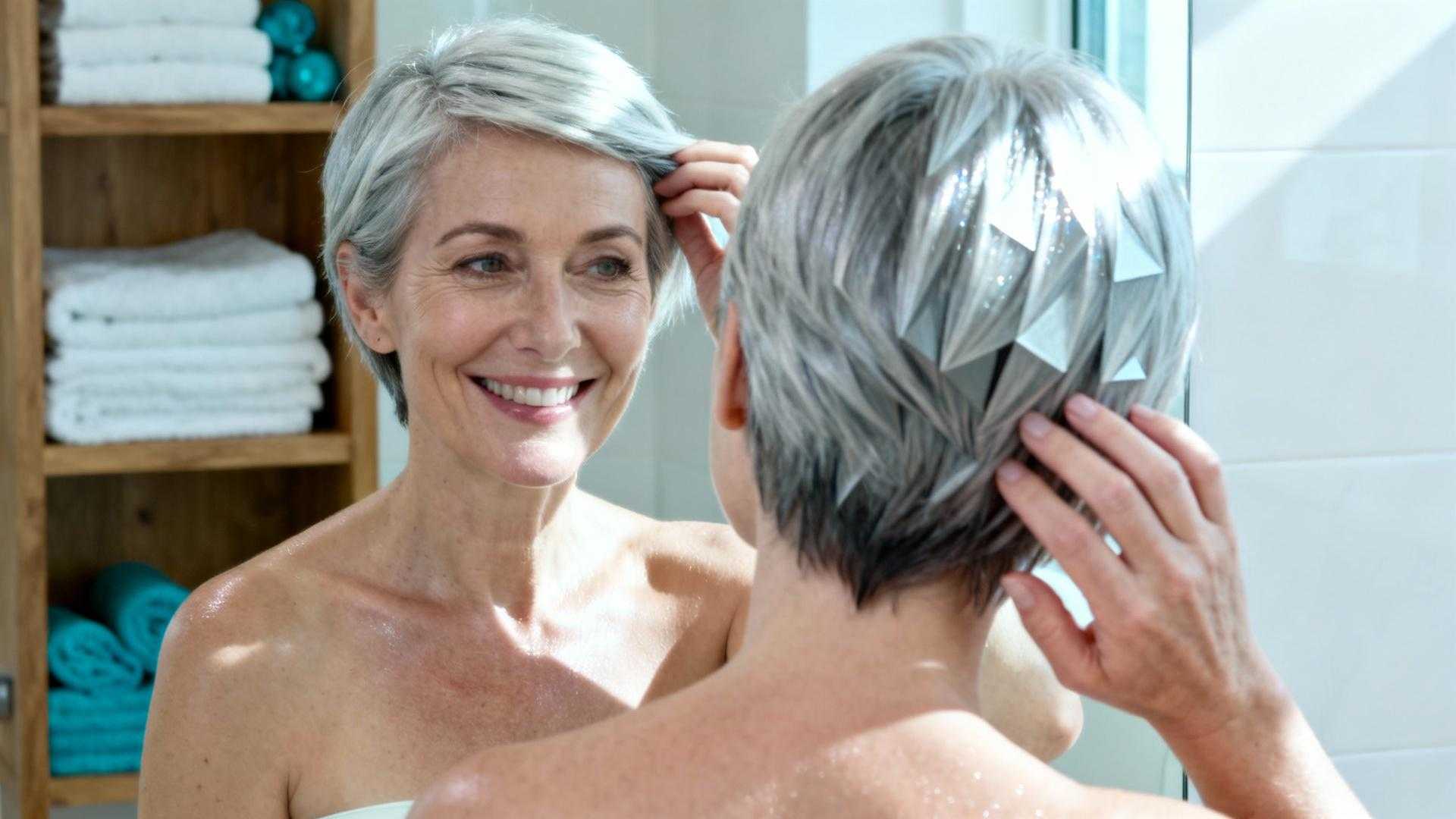Gray hair can appear flat and aging, or luminous and sophisticated. The difference isn’t the color itself, but how light interacts with hair geometry. This cropped haircut leverages optical principles to transform silver streaks into dimensional art. When cut short and properly textured, gray hair’s unique reflective properties create brilliance that longer styles can’t achieve.
The science behind this transformation involves understanding how unpigmented hair behaves with light. Gray hair functions as a natural optical fiber, transmitting and reflecting light differently than pigmented strands.
Why gray hair reflects light differently than pigmented hair
Gray hair lacks melanin, making strands more porous and coarser than pigmented hair. This texture change dramatically affects how light bounces off each strand. Light-colored hair demonstrates high albedo and low degree of linear polarization, with values below 0.2 compared to black hair’s 0.45.
This means gray hair reflects more diffuse light rather than harsh specular reflection. The hair shaft has a refractive index between 1.54 to 1.56 in the visible spectrum. When light hits gray hair, it creates both surface reflection and internal scattering.
Longer gray hair weighs down this natural texture, flattening the light-catching surfaces. Cropped styles maintain volume that allows light to hit strands from multiple angles. As celebrity hairstylists rebuild your hair’s reflective cuticle, they understand these optical principles.
The geometry of facial framing and silver enhancement
Cropped cuts position hair closer to the face where ambient light naturally illuminates features. When silver hair frames the face at jawline or above, it acts as a reflective surface that softens facial shadows.
How short lengths create facial light reflection
Professional stylists emphasize the popularity of textured pixie cuts for gray hair in this year. These geometric cuts create intentional light-catching angles. The closer proximity to facial features means reflected light bounces between hair and skin, creating a luminous halo effect.
Hair positioned at ear level catches light from overhead sources and windows. This creates natural highlights without chemical processing.
Angular cuts versus blunt edges for dimension
Blunt bobs can appear heavy with gray hair, creating a flat helmet effect. Graduated layers prevent this problem by positioning hair at varying angles. Sharp geometric cuts catch light at different degrees throughout the day.
These micro-angles create the illusion of multidimensional color within monochrome silver tones. This short haircut optically elongates your neck while maximizing light interaction across every strand.
Color enhancement techniques that amplify cropped silver styles
Balayage techniques add tonal variation to gray hair, preventing monotone flatness. Metallic highlights in silver, platinum, and icy tones create “light ribbons” throughout cropped styles. These enhancement methods work particularly well on shorter lengths.
Balayage and metallic highlights for sun-kissed depth
Professional colorists place highlights strategically in cropped cuts to maximize light diffusion. The average cost ranges from $50 to $100 for gray hair enhancement. These techniques create depth without overwhelming the natural silver base.
Metallic tones reflect light more intensely than traditional highlights. When applied to textured short cuts, they create movement and dimension that mimics natural sun exposure.
Strategic texture for maximum light diffusion
Texturing techniques like razor cutting and point cutting create micro-layers within cropped styles. These methods increase surface area and light-catching angles by approximately 40% compared to blunt cutting.
Messy, textured finishes work better for silver than sleek styles. They prevent the aging flat appearance while celebrating natural texture. Women are ditching expensive treatments and embracing these natural enhancement methods.
The confidence factor: why silver cropped styles feel liberating
Shorter silver styles signal intentional choice rather than resignation. Research shows 80% satisfaction rates for women embracing gray hair naturally. The visual contrast between bold short cuts and silver color creates fashion-forward statements.
The geometric precision of cropped styles communicates care and intention. This transforms gray from an aging marker to a deliberate style choice. Social media trends show 1.5 million Instagram posts celebrating natural gray hair transformations.
The liberation comes from working with natural changes rather than fighting them. Short protective styles offer versatility while showcasing silver’s natural beauty.
Your questions about this cropped silver haircut answered
Does this style work for all face shapes?
Oval faces suit most cropped styles naturally. Round faces benefit from asymmetrical angles that create visual length. Square faces need softened edges around the jawline to balance strong features.
How do I maintain vibrancy in silver cropped hair?
Purple shampoos neutralize yellow tones weekly. Moisturizing masks address texture changes, with premium products costing $20 to $40. Regular trims every 6 weeks maintain geometric precision and prevent split ends that dull reflection.
Can I achieve this look at home or do I need a salon?
Initial geometric cutting requires professional precision, with salon visits costing $50 to $100. Maintenance styling can be simplified with texturizing products. DIY touch-ups work for texture but avoid cutting angles yourself.
Morning light catches the precisely angled layers of your silver crop. Each strand reflects illumination like architectural elements designed for beauty. The geometry transforms natural aging into deliberate artistry that commands attention and admiration.
